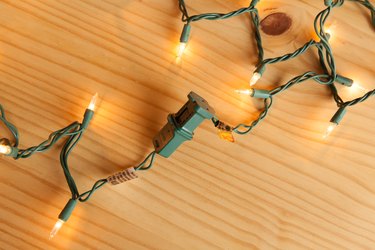
The female end of Christmas light plug ends can be dangerous if they fall into little hands, posing the risk of electrocution. During the holidays, when people use a lot of Christmas rope lights or traditional string lights, they might inadvertently leave some of those open plugs around the house, connected to power. If you have already set up your lights and want to close off that connector plug (female end) for any reason, there is a safe way to do it.
Important Notes on Working With Light Strings
Video of the Day
Though you can cut basic electrical wires, this exposes the copper wire inside. Always make sure the cord is unplugged before starting this project.
Video of the Day
It is possible to snip off the female plug to your Christmas lights with wire cutters. If you don't plan to connect the wire to anything else, cover it with electrical tape and heat shrink tubing.
Things You'll Need
Mask
Protective eyewear
Protective gloves
Wire cutters
Electrical tape
Heat shrink tubing
Utility knife
Wire stripper
Replacement plug
Terminal screw
Heat gun
How to Remove the Connector Plug at the End of Christmas Lights
Step 1: Find the Female End
Locate the female end of the light strand. This is the connector plug that you are likely looking to remove. Wear a mask, eye protection and protective gloves. Make certain that the strand of lights is not plugged into an outlet. The power should not be live.
Step 2: Cut Off the Plug
Snip off the female end of the cord with wire cutters. Remove the plug.
Step 3: Wrap With Electrical Tape
To safeguard the exposed wires after removing the female plug, wrap the ends of both wires separately with electrical tape. Then, secure the wires together with more electrical tape.
Step 4: Add Heat Shrink Tubing
Now, cover the wires with heat shrink tubing. The piece of tubing should be a bit larger than the wires; place it around them, allowing it to reach out another 1/4 inch or so. Hold the covered wire next to a heat gun and rotate the wire around until the tubing shrinks onto the wire. It should take a few minutes to cool and be good to go.
Working With Male Plugs
To remove and replace a male plug on an extension cord, use a utility knife to slice into the jacket about 3/4 inches from the end of the cord. Do not cut the three wires that are inside. Take a wire stripper and strip 1/2 inch of the insulation from each end of the wires.
Open up your replacement plug, attach each piece of exposed copper to the correct terminal screw, wrap it clockwise and tighten it securely. Put the replacement plug back together, and tighten the screws that attach it to the cord. To test it, plug it in a three-prong receptacle and put a plug-in circuit tester on the other end.
Removing Heat Shrink Tubing
If the heat shrink tubing has become damaged or loose, you can remove it. It is wise to wear protective gear whenever you are working with electricity, and this includes a mask, protective eyewear and gloves. Find the ends of the old tubing and carefully pry it back with a pair of pliers. Using a razor blade, cut the old tubing lengthwise, being careful not to cut through the wire. You should be able to remove the tubing. If you need to install new tubing, follow the instructions above.
When cutting pieces of heat tubing, cut them in cross sections and not straight across. If you cut it lengthwise, it is ruined. It cannot be reused, either; just dispose of it if it's damaged in this way. Keep in mind that there are different kinds of heat shrink tubing, with varying temperatures for shrinking them.
Be sure to read the instructions before picking up your heat gun. You cannot use electrical tape on its own to cover up exposed wires, since the adhesive wears off. Note that, while some people claim to use hair dryers with heat tubing, they do not get hot enough to complete the job.